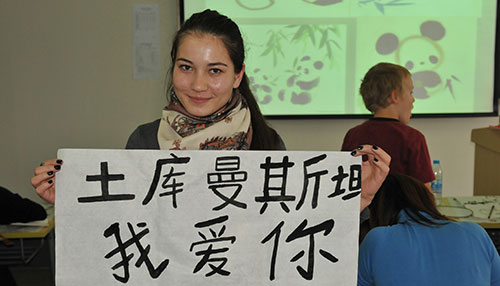Chinese Culture Theme Activity — Chinese Paper-cutting
Paper-cutting is one of the traditional Chinese folk arts. The first Chinese culture theme activity this semester, Chinese paper-cutting experience, was organized by Chinese Language Education Center in the afternoon of April 24th, 2014. All the participants showed great interest in paper-cutting. Under the guidance of Ms. Ni Hongxia, they finished a lot of fancy works and experienced this traditional Chinese cultural activity.
At first, Ms. Ni introduced the use and cultural connotation of paper-cut, the usage of paper-cutting instruments and paper-cut designs by texts and pictures. Then students appreciated representatively excellent paper-cut works. Through the appreciation, they could understand the paper-cut designs used in the works
Later in the practice, Ms. Ni chose the most common two designs, bean sprout shape and zigzag shape. After students drew the shapes on the practice paper, Ms. Ni taught the paper-cutting and they practiced.
Then it is the formal paper-cutting part. The first work, an eight folds mission flower paper-cut, was done through video clip. The second one was created by students referred to former paper-cut designs. They drew random shapes so the works were different from each other. The third one is the most difficult but the most beautiful and it was applied by a lot of zigzag shapes. When students opened their works, they were full of sense of achievement.
The last part was craving the shapes of little animals by graver. Students chose the shapes of horse, pig, rabbit and tiger. As it was the first time for they to crave, so some students couldn’t do it very well at the beginning. But later they gradually grasped the technique and finished all the craving. Though it was a hard working for students, they were very happy.
Through this activity, students know more about the history and cultural connotation of Chinese paper-cutting while through the experience, they feel the charm of traditional Chinese folk arts distinctly.

Foreign students practice Tai Chi in summer program
Tai Chi is an ancient Chinese form of exercise designed to relax and condition the body in harmony with Taoist notions of yin and yang, or opposing forces, for balance and flow. It combines ancient deep breathing techniques as a traditional form of physical training and is part of our cultural heritage.
There were foreign students from several dozen countries taking part, when the Shanghai Summer School Chinese Medicine Program held its Tai Chi experience to display the concepts of yin and yang and the Chinese martial arts, with performances by trainers.
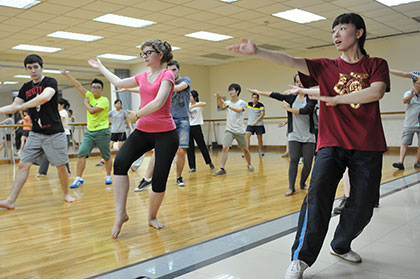 Students learning how to play Tai Chi. [Photo provided to China Daily]
Students learning how to play Tai Chi. [Photo provided to China Daily]
The foreign students experienced the flow and movements and the stances and positions of Tai Chi, as a means not only to good physical health, but also a peaceful mind and spiritual growth. Tai Chi is a ritual for living fully in the moment and that encourages learners to stay aware of the law of flowing energy to explore natural health and wellness.
Even though it is not easy to understand the ideas behind Tai Chi, the foreign students showed a strong interest, closely following trainer stance and movements, and practicing with great enthusiasm. And, even after the two-hour session came to an end, students lingered to discuss the gestures and motions and many of them expressed a fondness for the sport and an interest in studying it in-depth. So, the activity showed the delicacy of Chinese martial arts and built a base for spreading China’s traditional culture and friendly exchanges.
Foreign students enjoy making dumplings
Jiaozi, or dumplings, are a fond traditional Chinese food and a folk custom, especially for the Spring Festival Eve (the last day of a year on lunar calendar) in the north. In Southeast Asia, which has a large Chinese population, they have the habit of eating dumplings at the winter solstice, marking the start of winter on the lunar calendar.
Shanghai’s Summer School Chinese Medicine Program held a dumpling-making activity, on June 17, at the Shanghai University of Traditional Chinese Medicine, where students from several dozen countries got involved in the folk custom and got to taste their own craftsmanship.
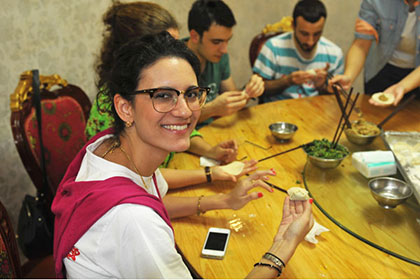 Students gathered in groups and made dumplings.
Students gathered in groups and made dumplings.
The vice-director of the school’s international education dept, Zhao Hailei, provided some introductory remarks on the origin and cultural meaning of dumplings, explaining that they go back as far as the Eastern Han Dynasty (25-220), when mutton dumplings were used to treat certain deficiencies or cold symptoms.
This made the students more interested in their own type and in therapeutic methods and herbal medicines.
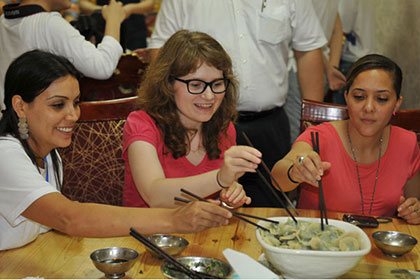 Students gathered in groups and made dumplings.
Students gathered in groups and made dumplings.
With the help of some volunteers, they began making dumplings in various shapes, such as crescent, triangular, or pentagonal and some hung around a bit longer to compare their work with that of others. The happiest moment of course was when they began consuming their creations with a rich sense of achievement and satisfaction.
Getting a taste of China through Wushu
Halfway through the 2014 Traditional Chinese Medicine Summer Program in Shanghai, the Institute of International Education of Shanghai University of Traditional Chinese Medicine (TCM) is preparing a series of activities for foreign students to help them experience Chinese culture. Among the activities, foreign students are most interested in Wushu performance and Wushu lessons.
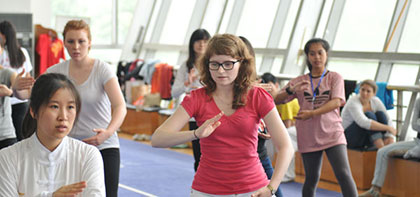 Foreign students learning Wushu.
Foreign students learning Wushu.
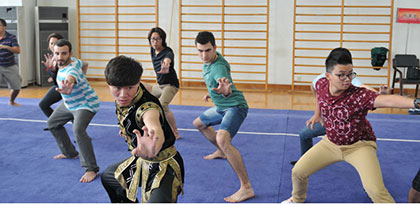 Foreign students learning Wushu.
Foreign students learning Wushu.
The Wushu team of Shanghai University of TCM, which won a first gold medal for Shanghai at the National University Games, impressed the foreign students with their performance. The students also got some experience with Wushu under the guidance of professional Wushu team members. Boys are mainly interested in the rigid Nanquan, while girls prefer Taiji boxing, which combines strength and softness. Students also showed interest in some handheld equipment.
The foreign students and members of the Wushu team also took pictures and exchanged contact information.
Blending in Shanghai - a wonderful cultural tour
A group of 20 international students from the summer program of Shanghai University of Traditional Chinese Medicine paid a visit to the waterfront town of Zhujiajiao and the Yida herbal medicine garden from June 28-29. Immersed in the waterside beauty, international students received a deeper understanding of Shanghai’s Haipai Culture, Chinese medicine and traditional Chinese culture.
Stepping into the Kezhi Garden on June 28, the biggest manor in Zhujiajiao, the students were exposed to picturesque sceneries. Secluded paths, winding bridges, refreshing air and pleasant flowers made the place more appealing. Students started a discussion about the architecture styles of China’s Ming and Qing dynasties (1368-1911), which led them to an exploration of exquisitely designed ancient gardens along the water.
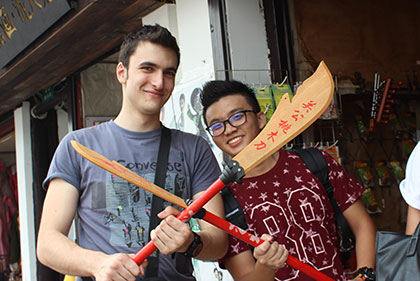 Students walked around the ancient town.
Students walked around the ancient town.
Afterwards, students joined in a gourmet walk around the small town. Quaint and elegant shops built in the Ming- and Qing-style stood along the streets. Scents of zongzi (traditional Chinese rice-pudding) and spiced pork trotter lured students into an abundant feast.
In the afternoon, students went to the well-preserved post office from the Qing Dynasty (1644-1911) in Zhujiajiao. Built in 1903, the post office was the earliest postal agency in East China and the only existing one from the Qing Dynasty. The pillar box with curled-up dragon engravings at the door had witnessed the changes in communication methods over the past 100 years. Students created postcards with special postmarks to recollect the past.
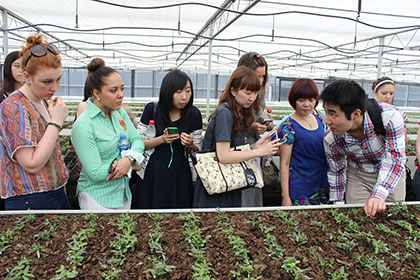 Students were visiting the herbal garden
Students were visiting the herbal garden
On June 29, students continued their visit to the Yida herbal medicine garden, where more than 460 herbs were planted. They could find every Chinese herb on record there, from common ones to rarely-seen herbs like hawksbill and velvet antler.
In the antique pharmacy, students were amazed at the crusted display of Chinese herbal medicine and various pharmaceutical facilities to make herbal medicine.
Blooming water lilies added more vitality to the lingering charm in the garden, driving students to pose for photos. Water lilies were also effective medicinal herbs for activating blood and dissolving stasis, relieving summer heat and reducing heat toxins.
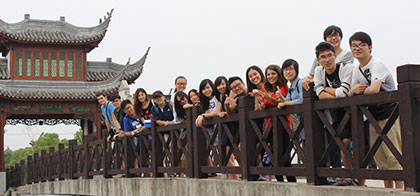 Students were making different poses in photo shooting.
Students were making different poses in photo shooting.
Before leaving, the students took group photos to remember the visit, which added to their personal experiences of China’s cultural intensity and folk customs.
Enter the black and white world of Chinese painting and calligraphy
On December 19, 2014, Chinese Language Education Center of Shanghai University of Traditional Chinese Medicine organized “Chinese calligraphy and painting experience" activities. The world of Black and white lines of ink attracted more than 30 students from Germany, USA, Brazil, South Korea, Thailand, Japan, Italy, Kyrgyzstan, Kazakhstan and other countries to participate in the experience. Under the guidance of teacher Cheng Jie, students have become attached ink, began a wonderful journey of calligraphy and painting.
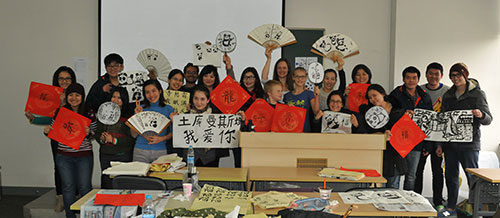
Calligraphy and Chinese characters, and paper and ink, brush, write and brush, teacher Cheng illustrations, introduced one by one, with his right. The first strokes on the paper, starts from the basic strokes. White rice paper smudged black lines, thick or thin, short or long, but did not affect the enthusiasm of writing students. Copying characters is a bigger challenge, students exercise one by one with intolerance, Chinese characters written in the red paper couplets have a kind of mold.
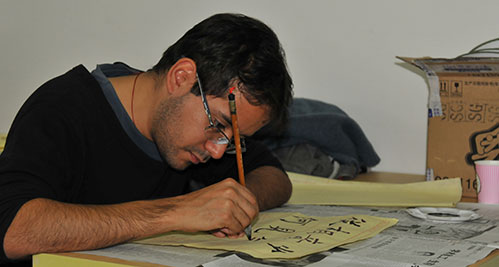
Teacher Cheng introduced students how to paint the panda and bamboo in the sector. Students are encouraged and inspired, can’t wait to free creation. Soon appeared all forms on the sector, vivid panda, somestudents also inscriptions dated in the sector, painting and calligraphy perfect fusion.
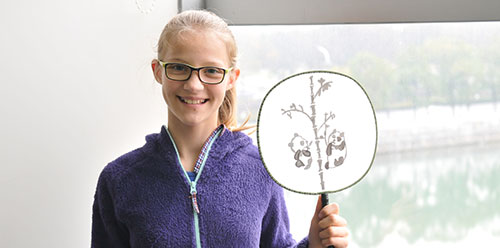
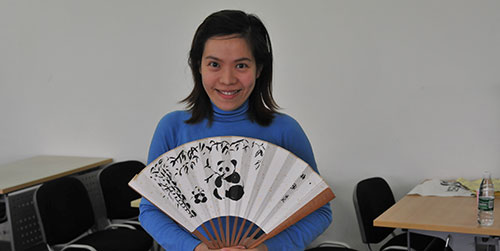
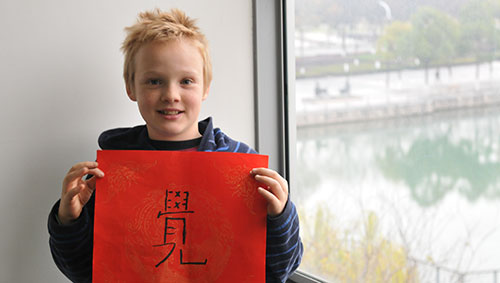
Black and white world of the Chinese painting and calligraphy is profound and implication of infinity. The event provided a starting point for students to understand the basic strokes of Chinese characters and writing skills, show them the unique charm of Chinese calligraphy and painting, international students had a more profound understanding about ancient and profound traditional Chinese culture in the sense.And inspire them continue to explore China's traditional culture, interest and enthusiasm.
